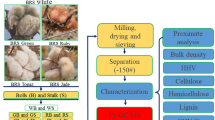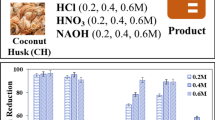Abstract
The use of cotton gin waste as a fuel is an attractive solution to the problems of disposing of a surplus agricultural waste as well as supplementing energy resources. Because a qualified alternative fuel must meet both environmental emission standards and industrial fuel standards, the physical characteristics of cotton gin waste and its toxic element concentrations are important for its initial objective evaluation as a fuel. Constituent components, moisture contents, and ash contents of four separate parts of cotton gin waste were determined and evaluated, closely following the American Society for Testing and Materials (ASTM) test methods. The three most toxic heavy metals, arsenic (As), chromium (Cr), and lead (Pb), chosen for quantitative analyses were also determined by using an inductively coupled plasma atomic emission spectrometry and a microwave oven sample digestion method. This study revealed that the lint component is the leading candidate for fuel, which closely meets both environmental emission and industrial fuel standards.
Similar content being viewed by others
References
Alberson, D. M. and Hurst, W. D., “Composting Cotton Gin Waste,” USDA, Agricultural Research Service (1964).
Columbus, E. P., Morris, N. M. and Rayburn, S. T., “Arsenic in Lint and Cotton Gin Emissions,”Transactions of the A.S.A.E.,27, 546 (1984).
Glad, Jr., E. H., Johnson, M. D. and Meyer, L. A., “Cotton Ginning Charges, Harvesting Practices, and Selected Marketing,” An Economic Research Service Report, USDA, March (1995).
Gordon, E., Keisling, T. G, Oliver, L. R. and Harris, C., “Two Methods of Composting Gin Trash,”Commun. Soil Sci. Plant Anal.,32, 491 (2001).
Griffin, Jr., A. G., “Fuel Value and Ash Content of Ginning Waste,”Transactions of the A.SA.E.,19, 156, 167 (1976).
Hughs, S. E., Wakelyn, P. J. and Rousselle, M. A., “Chemical Composition of Cotton Gin External Emissions: Crop Protection Products,”Transactions of the A.S.A.E.,40, 1685 (1997B).
Hughs, S. E., Wakelyn, P. J., Rousselle, M. A. and Columbus, E. P., “Chemical Composition of Cotton Gin External Emissions: Proximate and Elemental Analysis,”Transactions of the A.S.A.E.,40, 519 (1997A).
Lalor, W J. and Smith, M. L., “Use of Ginning Waste as an Energy Source,” Proceedings of the 1977 Cornell Agricultural Waste Management Conference, Cotton Incorporated, Raleigh, North Carolina, and Ann Arbor Science Publishers, Inc., Ann Arbor, Michigan, 449 (1977).
LePori, W A., Schacht, O. B., Lam, K. Y, Lacewell, R D. and Oursbourn, C. D., “Agricultural Residues: Resources for Energy in Texas,” Joint Southeast-Southwest Regional Meeting American Society of Agricultural Engineers, Houston, Texas, February 5–8 (1978).
Miller, C. S., Hoover W. L. and Price, J. D., “Pesticide Residues in Cotton Gin Wastes,” Texas Agricultural Exp. Sta., MP No. 1184, College Station, Texas (1975).
National agricultural statistics service, USDA, Cotton Ginnings, May (2002).
Newsletter from Pellet Fuels Institute, March–April, 12 (1995).
Parnell, C. B., Emino, E. R. and Grubaugh, E. K., “Cotton Gin Trash: Can it be Safely Utilized?”Agricultural Eng.,61, 21 (1980).
Pendleton, A. M. and Moore, V. P., “Ginning Cotton to Preserve Fiber Quality,” ESC-560, Federal Extension Service, USDA, 19 (1967).
Perkins, Jr., H. H. and Brushwood, D. E., “Strategies for Determining Arsenic Residues in Cotton and Cotton Waste,”Textile Chemist and Colorist,25, 31 (1993).
Public Information from Sandia National Laboratory, “Arsenic Background Soil Level,” USA (2003b).
Public Information from Sandia National Laboratory, “Chromium Background Soil Level,” USA (2003a).
Reddell, D. L., Parnell, C. B., March, T. and Hansford, D., “Composting Cotton Gin Trash,” Annual Board of Directors Meeting, Texas Cotton Ginners Association, Lubbock, Texas (1975).
Seiber, J. N., Winterlin, W. L., Ferguson, M., McChesney, M., Curley, R. G., Hills, D. V. and McCutcheon, O. D., “Report to Cotton Inc.,” 21 (1979).
Shafizadeh, F., “Pyrolysis and Combustion of Cellulosic Materials,”Advan. Carbohyd. Chem.,23, 419 (1968a).
Shafizadeh, F., “Pyrolysis and Combustion of Cellulosic Materials,”Advan. Carbohyd, Chem.,23, 448 (1968b).
Williams, T.D., Executive Director, Texas Cotton Ginners Association, personal communication with the author (2002).
Winterlin, W L., McChesney, M. M., Schoen, S. R. and Seiber, J. N., “Chemical Residues during Screening, Composting, and Soil Incorporation of Cotton Gin Waste,”J. Environ. Sci. Health, Part B,B21, 507 (1986).
Author information
Authors and Affiliations
Corresponding author
Rights and permissions
About this article
Cite this article
Kim, S., Park, S.K. & Daugherty, K.E. Some physical characteristics and heavy metal analyses of cotton gin waste for potential use as an alternative fuel. Korean J. Chem. Eng. 21, 640–646 (2004). https://doi.org/10.1007/BF02705499
Received:
Accepted:
Issue Date:
DOI: https://doi.org/10.1007/BF02705499




